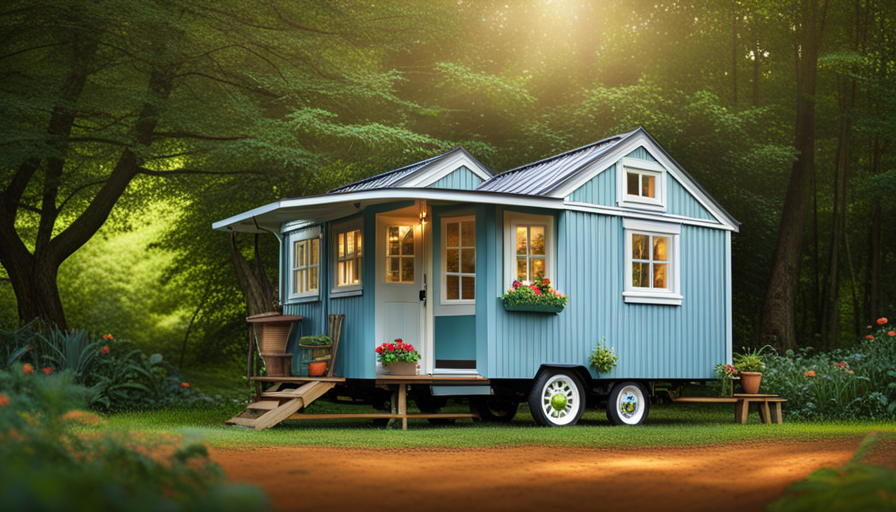Back in the day, I stumbled upon a delightful, cozy dwelling that captured my fancy – a tiny house. This enchanting sanctuary, resembling a fairy’s abode in size, enticed me with its cozy charm and promises of a more simple, eco-friendly lifestyle.
But as I delved deeper into the world of tiny houses, I realized that financing such a dream may not be as straightforward as I had hoped. How long, I wondered, can one obtain a mortgage for a tiny house?
In this article, we will embark on a quest to unravel the mysteries of tiny house financing. We will navigate through the intricate web of regulations, explore various financing options, and seek guidance from experts in the field.
So come, join me on this magical journey as we uncover the secrets to securing a mortgage for your very own tiny house.
Key Takeaways
- The duration of a mortgage for a tiny house can vary depending on the financing option chosen.
- Typical mortgage terms for tiny houses range from 10 to 30 years.
- Shorter mortgage terms often come with lower interest rates.
- Factors such as loan amount, interest rate, and credit score influence the length of a mortgage.
Understanding the Definition of a Tiny House
So, how long can you actually secure a mortgage for your adorable little dream home? Well, before we dive into the details, let’s first define what a tiny house is.
A tiny house is a compact dwelling that typically ranges from 100 to 400 square feet in size. It’s designed to maximize functionality and minimize unnecessary space.
Now that we have a clear understanding of what constitutes a tiny house, let’s explore the benefits of living in one.
Living in a tiny house offers numerous advantages. Firstly, it provides a simplified lifestyle, allowing you to focus on what truly matters. With fewer possessions and a smaller living space, you can save both time and money. Additionally, tiny houses are eco-friendly, requiring less energy to heat and cool. They also promote a sense of community, as they can be built in clusters or on wheels, offering flexibility and the opportunity to travel.
Now that we’ve examined the features and benefits of living in a tiny house, let’s transition into exploring financing options.
While securing a mortgage for a traditional house is relatively straightforward, the process for a tiny house can be more complex. However, with the growing popularity of tiny houses, more lenders are beginning to offer specialized mortgage options.
Exploring Financing Options for Tiny Houses
When it comes to financing options for compact dwellings, the duration of the loan can vary. There are several alternative funding options available for those looking to purchase a tiny house, and the length of the mortgage can depend on a few factors.
-
One option is to secure a traditional mortgage through a lender. This typically offers longer loan terms, ranging from 15 to 30 years, allowing borrowers to spread out their payments over a longer period of time.
-
Another option is to explore personal loans or lines of credit, which may offer shorter terms, typically ranging from 3 to 7 years. These loans can be obtained from banks, credit unions, or online lenders.
-
Additionally, some tiny house builders offer in-house financing options, where buyers can obtain a loan directly from the builder. These loans often have shorter terms, usually ranging from 5 to 10 years.
It’s important to note that the location of the tiny house can also impact the financing options available. Some lenders may have restrictions on lending for properties that are not permanently affixed to a foundation or located in certain areas.
Determining the length of a tiny house mortgage depends on various factors, including the borrower’s financial situation, preferences, and the specific financing options available.
Determining the Length of a Tiny House Mortgage
When considering a mortgage for a tiny house, it’s important to understand the typical mortgage terms that are available.
Factors such as loan amount, interest rate, and credit score can all influence the length of the mortgage.
By understanding these factors, I can make an informed decision on the best mortgage length for my tiny house.
Typical Mortgage Terms for Tiny Houses
To fully enjoy your tiny house journey, you’ll be thrilled to learn that mortgage terms for these charming abodes typically range from 10 to 30 years. Here are three key details to consider when it comes to mortgage terms for tiny houses:
-
Typical interest rates: Just like traditional mortgages, the interest rates for tiny house mortgages can vary depending on factors such as your credit score and the lender you choose. However, it’s worth noting that interest rates for shorter mortgage terms tend to be lower compared to longer terms.
-
Benefits of a shorter mortgage term: Opting for a shorter mortgage term can offer several advantages. Firstly, you’ll pay off your mortgage sooner, which means you’ll build equity in your tiny house faster. Additionally, shorter terms often come with lower interest rates, saving you money in the long run.
-
Factors that influence mortgage length: While the typical mortgage terms for tiny houses range from 10 to 30 years, the actual length of your mortgage will depend on various factors. These factors include your financial situation, the cost of your tiny house, and your individual preferences.
By understanding these details, you can make informed decisions about the length of your tiny house mortgage.
Factors that Influence Mortgage Length
Consider various factors such as your financial situation, the cost of your dream home, and your personal preferences, in order to determine the ideal length of your mortgage, right?
When it comes to tiny houses, there are several factors that can influence the length of your mortgage. One of the main factors is the current mortgage rates, which can fluctuate based on market conditions and the overall economy.
Additionally, the size of your down payment can also impact the length of your mortgage. A larger down payment can potentially shorten the length of your mortgage, as it reduces the amount of money you need to borrow. On the other hand, a smaller down payment may result in a longer mortgage term.
Considering these factors, it’s important to carefully evaluate your options and consider alternative financing methods if necessary.
Considering Alternative Financing Options
Looking for alternative financing options? You can explore how long you can get a mortgage for a tiny house. When it comes to financing a tiny house, traditional mortgage options may not always be the best fit. However, there are alternative financing options available that can help you achieve your dream of owning a tiny house.
One option to consider is working with lenders who specialize in tiny house financing. These lenders understand the unique nature of tiny homes and can offer flexible mortgage terms to accommodate your needs. Depending on the lender, you may be able to find mortgages with terms ranging from 10 to 30 years. Keep in mind that the length of the mortgage will ultimately depend on factors such as your creditworthiness and the specific lender’s criteria.
Working with lenders specialized in tiny house financing can provide you with the expertise and resources needed to navigate the unique challenges of financing a tiny home. They can offer guidance on the best loan options available and help you understand the potential benefits and drawbacks of each option. By exploring alternative financing options and working with specialized lenders, you can find a mortgage that aligns with your goals and allows you to enjoy the benefits of tiny house living.
Working with Lenders Specialized in Tiny House Financing
When working with lenders who specialize in financing tiny homes, they’ll guide you through the unique challenges and help you navigate the path to owning your dream small abode. These specialized lenders understand the specific needs and requirements of financing tiny houses, and they can provide you with tailored loan terms that suit your situation. Here are five key points to consider when working with these lenders:
-
Flexibility: Specialized lenders often offer more flexible loan terms compared to traditional mortgage lenders. They understand that tiny houses may not fit the conventional mold and can work with you to find a financing solution that meets your needs.
-
Experience: These lenders have experience working with tiny house buyers and builders, which means they’re familiar with the intricacies of the process. They can provide valuable insights and advice throughout the financing journey.
-
Knowledge of regulations: Tiny houses may have different regulations and zoning requirements compared to traditional homes. Specialized lenders are well-versed in these regulations and can ensure that your financing aligns with the necessary guidelines.
-
Understanding of the tiny house market: Specialized lenders have a deep understanding of the tiny house market and can help you determine the value of your small abode. This knowledge can be crucial during the loan approval process.
-
Personalized service: Working with specialized lenders means you can expect personalized service tailored to your unique situation. They’ll take the time to understand your needs and work with you to find the best financing solution.
Understanding the importance of credit score is essential when securing a loan for your tiny house.
Understanding the Importance of Credit Score
Don’t underestimate the impact your credit score can have on your chances of obtaining the loan for your dream small abode. Building credit is an essential step in the process of securing a mortgage for a tiny house.
Lenders will use your credit score to assess your creditworthiness and determine the interest rate you qualify for. A higher credit score indicates a lower risk for the lender, increasing your chances of loan approval and potentially securing a more favorable interest rate.
To ensure you have a good credit score, it’s important to make all your payments on time, keep your credit utilization low, and avoid opening unnecessary lines of credit. It’s also a good idea to regularly check your credit report for any errors or discrepancies that could negatively impact your score.
Understanding the importance of credit score in the mortgage application process is crucial. It not only determines your eligibility for a loan but can also save you a significant amount of money in the long run. So, before applying for a mortgage for your tiny house, take the time to assess your creditworthiness and make any necessary improvements to your credit score.
Moving forward, researching state-specific regulations and zoning laws is the next crucial step in the process of financing your tiny house.
Researching State-Specific Regulations and Zoning Laws
Researching state-specific regulations and zoning laws is crucial for understanding the legal requirements and restrictions that may impact your plans for a small home. Each state has its own set of regulations and building codes that dictate what you can and cannot do when it comes to constructing a tiny house.
Here are some key points to consider:
-
Maximum square footage: Some states have specific limits on the size of a tiny house. It’s important to know the maximum square footage allowed in your state to ensure compliance with the regulations.
-
Minimum lot size: Certain states may have minimum lot size requirements for tiny houses. This means that you may need to have a certain amount of land in order to legally place a tiny house on it.
-
Zoning restrictions: Different zoning laws may apply to tiny houses depending on their classification. It’s important to research the zoning regulations in your desired location to determine if a tiny house is allowed and if there are any restrictions on where it can be placed.
-
Building codes: Understanding the building codes in your state is crucial for ensuring that your tiny house meets all safety and construction standards. This includes requirements for electrical, plumbing, and structural components.
By researching state-specific regulations and reviewing building codes, you can ensure that your plans for a tiny house comply with all legal requirements. Consulting with a mortgage broker or financial advisor will help you understand how these regulations may impact your ability to obtain a mortgage for your small home.
Consulting with a Mortgage Broker or Financial Advisor
To make your journey towards owning a cozy abode smoother, it’s wise to seek guidance from a mortgage broker or financial advisor who can provide valuable insights and help navigate the intricate world of home financing.
Consulting with a mortgage broker offers several benefits when it comes to securing a mortgage for a tiny house. These experts have vast knowledge of the lending industry and can provide guidance on available loan options, interest rates, and repayment terms specifically tailored to your needs. They can also help you understand the requirements and qualifications for obtaining a mortgage, ensuring you have all the necessary documents and information ready for the application process. Additionally, a mortgage broker can negotiate with lenders on your behalf, potentially securing more favorable terms and saving you both time and money in the long run.
When it comes to mortgage decisions, a financial advisor can also play a crucial role. They can assess your financial situation, including your income, expenses, and credit score, to determine the best mortgage options for you. A financial advisor can provide advice on budgeting, saving, and improving your credit score, which can positively impact your ability to secure a mortgage for a tiny house. They can also help you understand the long-term financial implications of your mortgage decision, including potential tax benefits and investment opportunities.
As you explore grants and financial assistance programs for a tiny house mortgage, the guidance provided by a mortgage broker or financial advisor will prove invaluable. They can help you identify potential funding sources and navigate the application process, ensuring you have the best chance of securing the financial assistance you need.
Exploring Grants and Financial Assistance Programs
If you’re looking for financial assistance for your dream of homeownership, exploring grants and assistance programs can open up opportunities for you to secure funding for your cozy abode. Grants are available for various purposes, including building sustainable and energy-efficient homes.
By researching and applying for these grants, you may be eligible to receive a substantial amount of money towards the construction of your tiny house.
When it comes to grants, availability can vary depending on your location and the specific criteria set by the grant provider. Some grants may only be available to certain groups of people, such as low-income individuals, veterans, or first-time homebuyers. It’s important to thoroughly research the grants available in your area and determine if you meet the eligibility criteria.
Additionally, grants may have specific requirements or conditions that must be met. This could include using specific materials or building methods that align with sustainability standards. It’s essential to familiarize yourself with these requirements to ensure you can comply with them when constructing your tiny house.
Exploring grants and financial assistance programs can be an excellent way to secure funding for your tiny house project. However, it’s important to weigh the pros and cons of different financing options as well.
Transitioning into the next section, we’ll explore the various financing options available and discuss their advantages and disadvantages.
Weighing the Pros and Cons of Different Financing Options
When considering how to finance your dream of homeownership, it’s important to weigh the advantages and disadvantages of different options.
One popular financing option to consider is a fixed rate mortgage. With a fixed rate mortgage, the interest rate remains the same for the entire duration of the loan, providing stability and predictability in monthly payments. This can be beneficial for those who prefer a consistent payment amount and want to avoid any surprises in the future. However, it’s important to note that fixed rate mortgages typically have higher interest rates compared to adjustable rate mortgages.
Another option to consider is an adjustable rate mortgage (ARM). With an ARM, the interest rate can fluctuate over time based on market conditions. This means that your monthly payment amount could increase or decrease depending on the interest rate changes. ARMs often offer a lower initial interest rate compared to fixed rate mortgages, making them attractive to borrowers who plan to sell or refinance their home before the rate adjustments occur.
When weighing the pros and cons of fixed rate mortgages and considering adjustable rate mortgages as an option, it’s important to consider the following:
- Stability and predictability of monthly payments with a fixed rate mortgage
- Potential for lower initial interest rates with an adjustable rate mortgage
- Risk of higher interest rates in the future with an adjustable rate mortgage
- Ability to refinance or sell the home before rate adjustments with an adjustable rate mortgage
- Long-term financial goals and plans for the home
By carefully considering these factors, you can make an informed decision about the best financing option for your tiny house.
Frequently Asked Questions
Can I get a mortgage for a tiny house if I have a low credit score?
If you have a low credit score, obtaining a mortgage for a tiny house can be challenging, but it’s not impossible.
According to recent statistics, around 30% of Americans have credit scores below 601. Despite this, there are still mortgage options available for individuals with low credit scores.
It’s important to research and explore lenders who specialize in working with borrowers in similar situations. They may offer alternative loan programs or consider other factors, such as income and employment history, when evaluating your application.
Are there any grants or financial assistance programs available for financing a tiny house?
Yes, there are grants and financial assistance programs available for financing a tiny house. These options can provide valuable support for individuals looking to purchase a tiny house.
Grants can offer funding that doesn’t need to be repaid, while financing options provide loans with favorable terms. These programs aim to make financing a tiny house more accessible and affordable for individuals seeking an alternative housing solution.
What are the pros and cons of different financing options for tiny houses?
When considering financing options for a tiny house, using personal savings can offer a symbol of financial independence and security. The pros include avoiding interest payments and maintaining full ownership. However, it may deplete your savings and limit your financial flexibility.
On the other hand, using a personal loan can provide immediate funds and allow for flexible repayment options. However, the cons include interest payments and the potential for higher overall costs.
How can I research state-specific regulations and zoning laws for my tiny house?
When researching regulations and zoning laws for a tiny house, it’s important to start by understanding the specific requirements of your state.
Begin by visiting your state’s official website and look for resources related to housing regulations and zoning laws.
Additionally, you can reach out to local government offices, such as the planning or zoning department, for more information.
It’s crucial to thoroughly research and understand these regulations to ensure compliance and avoid any legal issues when building or living in a tiny house.
Is it necessary to consult with a mortgage broker or financial advisor when financing a tiny house?
Consulting with a mortgage broker or financial advisor is highly recommended when financing a tiny house. These professionals have the knowledge and expertise to guide you through the complex process of securing a loan for a non-traditional property. They can help you understand your options, navigate the paperwork, and ensure you make informed decisions.
Their expertise will be invaluable in finding the best financing solution for your tiny house project.
Conclusion
In conclusion, when considering financing options for a tiny house, it’s crucial to explore all possibilities and weigh the pros and cons. By working with specialized lenders, researching state-specific regulations, and consulting with professionals such as mortgage brokers or financial advisors, individuals can find the best solution for their unique situation.
Additionally, exploring grants and financial assistance programs can provide further opportunities for funding. Ultimately, thorough research and careful consideration will lead to a mortgage that’s both manageable and tailored to the specific needs of a tiny house owner.
Hi, I’m Emma. I’m the Editor in Chief of Tiny House 43, a blog all about tiny houses. While tree houses are often associated with childhood, they can be the perfect adult retreat. They offer a cozy space to relax and unwind, surrounded by nature. And since they’re typically built on stilts or raised platforms, they offer stunning views that traditional homes simply can’t match. If you’re looking for a unique and romantic getaway, a tree house tiny house might just be the perfect option.










